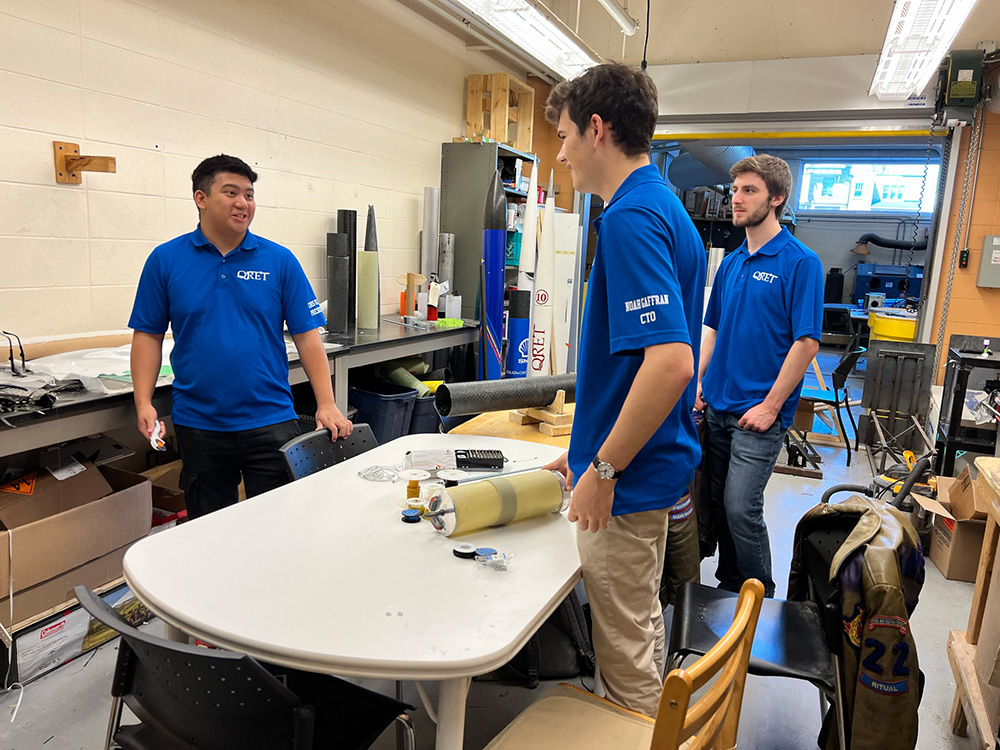Chris Viloria and Noah Gaffran will be in the middle of a desert in New Mexico later this month, counting down from 10. Several other members of the Queen’s Rocket Engineering Team (QRET) will be nearby to launch the rocket they’ve all built together.
The only other sound will be the wind whipping across the arid landscape.
At least until they hit “one.”
That’s when a flash of fire and a roaring boom will rip from the rocket’s tail to mark the start of its journey to 30,000 feet. Travelling at 1.8 times the speed of sound, the three-metre-tall projectile will only take about 40 seconds to get there. The motor will burn for just the first six of those seconds.
“It will be loud,” says Gaffran, QRET’s chief technical officer.
“And it’ll have a big smoke trail,” adds Viloria, the team’s president.
The New Mexico launch will mark the culmination of another ten months of work for the 50 or so QRET members. Almost every year since 2015, the student design team has built a rocket from scratch to vie for the Spaceport America Cup in New Mexico, the world’s largest intercollegiate rocket engineering conference and competition. QRET also battles at the annual Launch Canada student rocket competition in late August.
Most years, the team has entered itself in the 10,000 feet categories of these competitions, but more recently they’ve gone for the 30,000 feet categories.
“It’s more of a challenge, but it’s a lot more fun because the rocket goes a lot faster,” says Gaffran, who recently completed his final year of Mechanical Engineering at Queen’s.

Photo: Chris Viloria, Kennan Bays, and Noah Gaffran at work in the team design studio.
Competition isn’t just about speed or altitude, however. Teams must also send up a new scientific experiment aboard their rockets each year. For the 2023 Spaceport America Cup, QRET will be trying to reclaim some of the energy lost from the vibration of the rocket using levitating neodymium magnets and electromagnetic coils. For the Launch Canada competition, the team is building a tracking station to monitor where the rocket is in its flight trajectory.
Putting it all together is a big challenge that takes students from most engineering disciplines and multiple sub-teams. But that’s part of the fun and the learning experience, says Viloria, who has been part of QRET since his first year and has just completed his final year of Engineering Physics.
“Having had so many members from every single discipline has meant that I’ve naturally just picked up a lot of different skills,” he says. “If I don’t think that that I’m the most competent in one area, just by being around other people and learning from what they have expertise-wise, I’m really able to observe and get my skillset up that way.”
Gaffran agrees and says that it’s been incredibly valuable to put these skills to use on a large, hands-on project like a rocket. He and Viloria both want careers in the aerospace industry, and they know from speaking with QRET alumni how important design team experience can be.
“We’ve had previous members go on to places like MIT, Stanford, and big companies like MDA [famous for building the Canadarm2 on the International Space Station],” says Viloria. “And when we ask them about how they got these positions, they always talk about their time on the rocket team and how that levelled up their engineering degree from the standard one where they just had high grades to one where they really stood out as a candidate.”
No doubt he and Gaffran will be thinking about those alumni and QRET’s network of knowledge when they’re standing in the desert in New Mexico this June.
“It’s about building something greater than its parts,” says Gaffran. “And it’s just amazing to see a design go from an idea on a screen to parts in a shop to a rocket on a launch rail with a countdown going down. You can’t learn those skills anywhere else.”
